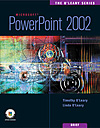

 Office XP PowerPoint 2002, 2/e Copying, Embedding, and Linking Between Applications Working Together 1- Quiz |

 2002 McGraw-Hill Higher Education
2002 McGraw-Hill Higher EducationAny use is subject to the Terms of Use and Privacy Policy.
McGraw-Hill Higher Education is one of the many fine businesses of The McGraw-Hill Companies.